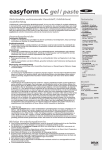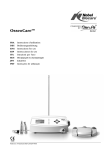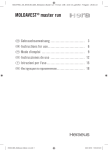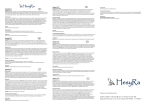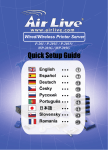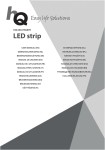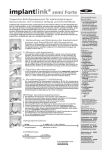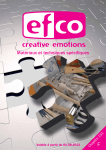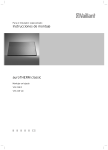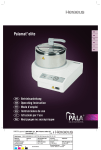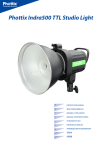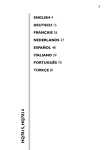Download easyform LC gel / paste GB
Transcript
easyform LC gel / paste Light-curing, mouldable resin that burns out without residue Light-curing, ready-to-use, single component material for use as a modelling gel and paste for multiple indications in dental engineering, especially mould casting. The gel is applied straight from the metering syringe and the paste can easily be moulded into shape thanks to its kneadable consistency. easyform LC can be polymerised in all currently available light-curing devices. After the final curing the material can easily be trimmed both by the micro engine and by milling devices. easyform LC burns out without residue during the preheating of the casting mould. Fields of application Fixed dentures Models for casting crowns and bridges, ceramic frameworks, inlays and onlays Fabrication of frameworks for copy milling machines and frameworks for galvano bridges Combination technique Primary and secondary components for the telescopic and tapered crown technique, customised attachments, secondary components for groove-shoulder-pin attachments, stress distribution arms, secondary brace supports with interlocks, customised bars etc. Implantology Models for casting implant abutments, implant bars and implant superstructures and tertiary frameworks. Fabrication of transfer and fixation keys and splinting or fixation of customised parts of implants or segments Joining technique and fixations Fixation of parts or segments by soldering or welding Fixation of prefabricated attachments, general splinting or fixation for repairs or trying in dentures Transfer and bite check Transfers splints and keys, that is insertion guides, occlusal bite splints, stops and check bites 1. Preparation Insulate the surfaces of the plaster with standard alginates. Vaseline is suitable for insulating polyurethane modelling materials. As a rule, no further insulation is required on polished metal or ceramic surfaces. If necessary, apply a wafer thin layer of Vaseline or oil, blowing off any excess oil. 2. Application Remove the protective cap from the application syringe. Fit black application needles onto the application syringe and lock in place. Press the piston lightly to dispense and model the material. The material flows easily and can be guided while the tip is being moved in the material but stops flowing as soon as the tip is stationary. When modelling parts with thicker walls, apply the material in several thinner layers of approx. 1 mm. Before applying the next layer an intermediate polymerisation of 20 sec. duration is recommended for the handheld lamp or 60 sec. for the laboratory apparatus. This prevents incomplete curing, excessive release of heat or stresses. After use reseal the syringe with the protective cap. Remove the paste with a spatula or dental instrument. Always replace the lid of the paste tin immediately after removing the material in order to protect the contents from the light. Preparatory shaping can be carried out by hand. Use the paste for applying larger amounts of the material quickly and effectively and the gel for corrections and jointing. After the final polymerisation the model can be trimmed or shaped in the milling device. The model should be covered with a thin layer of modelling wax for large scale work. 3. Curing easyform LC gel/paste can be polymerised in all currently available light-curing devices with a light spectrum of 320 nm to 435 nm. Devices with a curing chamber equipped with a cooling system are also suitable. The average polymerisation times in light-curing devices with UV/UV-A lamps are approx. 3 min. 30 sec. to 5 min., for halogen lamps approx. 2 min., for stroboscopic lamps approx. 1 min. 30 sec. and for LED lamps approx. 20 sec. It should be noted that the polymerisation time is always dependent on the lamp in the device. Consistent curing times can be guaranteed only by the use of regularly maintained devices. Follow the manufacturer’s instructions. Important points to observe when using the material In order to achieve optimum casting results and cast surfaces, the oxygen inhibition layer must be completely removed before model is immersed in isopropanol. Modelling of easyform LC paste is greatly facilitated by coatings fingers or instruments with petroleum jelly. The occasional forming of separations on the paste surface in the tin is due to changes in temperature and does not represent animpairment of the paste. Trimming and polishing should be carried out only at workplaces equipped with dust extraction units. Avoid contact of the product with the mucous membranes and eyes. If accidental contact occurs, rinse under running water and seek medical assistance if necessary. Material that has not been cured can cause irritation and sensitisation if it comes into contact with the skin and mucous membranes. Carefully reseal tin and syringe immediately after use. The product has been developed for use in dental applications and must be used only for its intended purpose by qualified personnel. Observe the safety data sheet. GmbH & Co. KG Carl-Zeiss-Str. 4 · 76275 Ettlingen/Germany www.detax.de · [email protected] Made in Germany 04/2013 GB Instructions for use Technical data: Volumes 3 g syringe/30 g tin Dispensing and application Direct application by application needles or spatula Product colour transparent red Curing Light-curing devices with a light spectrum of 320 nm to 435 nm UV/UV-A lamps approx. 3 min. 30 sec. to 5 min. Halogen lamps approx. 2 min. Stroboscopic lamps approx. 1 min. 30 sec. LED lamps approx. 20 sec. Intermediate polymerisation per 1 mm layer Hand held lamp approx. 10 sec. Laboratory apparatus approx. 60 sec. Application 23 °C ± 2 °C, 50 ± 5% relative humidity Storage Protect from light. Do not store in the refrigerator. Ordering Information: easyform LC Gel 03376 3 x 3 g syringes 10 application needles Paste 30 g tin Application needles 10 needles 03375 02714 easyform LC gel / paste Résine calcinable sans résidus, photopolymérisable et facile à modeler Matériau à un composant photopolymérisable prêt à l’emploi, sous forme de gel et de pâte, adapté à de multiples indications dentaires multiples et plus particulièrement à la de coulée. Le gel s’applique directement grâce à la seringue de dosage. La pâte est facile à manipuler et à modeler grâce à sa consistance pétrissable. easyform LC peut être polymérisé avec tous les modèles courants de l technologique ampes à polymérisation. Après le durcissement final, la surface peut être facilement meulée avec un micromoteur ou à une fraiseuse. easyform LC est calcinable sans résidus pendant le préchauffage du moule de coulée. Champs d’application Prothèse fixe Modèles pour la coulée de couronnes, de bridges, d’armatures en céramique, d’inlays et d’onlays. Réalisation d’armatures pour fraiseuses à reproduire et pour bridges par galvanoplastie. Technique combinée Parties primaires et secondaires de couronnes télescopique et coniques, gouttières individuelles, parties secondaires rainures–épaulement–tige, répartiteurs de forces, contournements secondaires avec stabilisateur, barres individuelles Implantologie Modèles pour la coulée de piliers, de barres et de superstructures d’implants et d’armatures tertiaires. Réalisation de clés de fixation et de transfert, solidarisation ou fixation de chaque partie ou segment d’implants. Technique d’assemblage et fixations Fixations d’éléments ou de segments avec la technique d’assemblage par brasage ou par soudure Fixation de gouttières, solidarisation générale ou fixations de réparations ou d’essais Transfert et contrôle de l’occlusion Rails de transfert et clés, auxiliaires d’insertion, rails de contrôles de l’occlusion, clé interocclusale et taquets occlusaux 1. Préparation Isolez la surface du plâtre avec de l’alginate. Il convient d’appliquer de la vaseline sur les modèles en polyuréthane. Il n’est en général pas nécessaire d’isoler les surfaces polies en métal ou en céramique. Appliquez éventuellement une fine couche de vaseline ou d’huile. 2. Application Retirez le capuchon de la seringue d’application. Placez l’aiguille d’application sur la seringue d’application et visser. Appuyez légèrement sur le piston pour extraire et modeler le matériau. Lorsque vous déplacez l’embout, le matériau présente une excellente fluidité et peut être appliqué avec précision; il cesse de couler dès que vous interrompez l’application. Pour modeler des éléments avec une épaisseur de paroi importante, appliquez le matériau en plusieurs couches fines d’environ 1 mm. Avant d’appliquer une couche supplémentaire, il est recommandé de procéder à une photopolymérisation intermédiaire pendant environ 20 sec. avec une lampe manuelle, ou 60 sec. avec une lampe de laboratoire. Cette précaution prévient les durcissements incomplets, la libération excessive de chaleur et les tensions. Après son utilisation, refermez la seringue avec le capuchon. Prélevez de la pâte avec une spatule ou tout autre instrument adapté. Après le prélèvement, refermez immédiatement le pot afin de protéger son contenu de la lumière. La mise en forme préalable peut se faire manuellement. La pâte est une forme adaptée à la manipulation rapide et efficace de grandes quantités de matériau. Vous pouvez réaliser ensuite les corrections et les jonctions à l’aide du gel. Après la photopolymérisation finale, il est possible de meuler ou de travailler la surface avec une fraiseuse. En cas de travail sur de gros volumes, il faut recouvrir le moulage d’une fine couche de cire à modeler. 3. Durcissement La photopolymérisation d’easyform LC gel/pâte peut s’effectuer avec toutes les lampes à polymérisation courantes d’une longueur d’onde comprise entre 320 nm et 435 nm. Il est également possible d’utiliser les appareils qui disposent d’une fonction de refroidissement de la chambre de polymérisation. Les temps de polymérisation moyens s’élèvent à environ 3 min. 30 sec. et 5 min. pour les lampes à UV/ UVA, 2 min. pour les lampes halogènes, 1 min. 30 sec. pour les lampes stroboscopiques et 20 sec. avec les lampes à DEL. Nous attirons votre attention sur le fait que les temps de polymérisation dépendent toujours du type de lumière utilisé par l’appareil. Seuls des appareils bénéficiant d’une maintenance régulière peuvent assurer des temps de durcissement constants. Veuillez vous conformer aux indications du fabricant de l’appareil. Remarques importantes Pour obtenir des résultats de coulée optimaux et une excellente qualité de surface, il faut éliminer intégralement la couche d’inhibition composée d’oxygène avec de l’isopropanol avant de procéder au revêtement. Le modelage d'easyform LC paste est facilité considérablement lorsque les doigts ou les instruments sont isolés au moyen de vaseline. Le changement de température peut entraîner une dissociation occasionnelle mais sans incidence de la pâte en surface dans la boîte. Lors du fraisage et du polissage, assurez une aspiration adéquate des poussières au poste de travail. Évitez le contact avec les muqueuses et les yeux. En cas de contact accidentel, rincez abondamment à l’eau claire et consulter un médecin. En cas de contact avec la peau et les muqueuses, le matériau non polymérisé peut provoquer des irritations et une sensibilité. Refermez soigneusement, immédiatement après usage. Ce produit a été conçu pour une utilisation dans le domaine dentaire et ne doit être manipulé que par un personnel spécialement formé. Lire la fiche de données de sécurité. F Mode d’emploi Caractéristiques techniques: Volume Seringue de 3 g Pot de 30 g Dosage et application Application directe avec l’aiguille d’application ou une spatule Couleur du produit rouge transparent Durcissement Longueur d’onde comprise entre 320 nm et 435 nm Lampe à UV/UVA env. 3 min. 30 sec–5 min. Lampe halogène env. 2 min. Lampe stroboscopique env. 1 min. 30 sec.* Lampe à DEL env. 20 sec. Polymérisation intermédiaire par couche de 1 mm Lampe manuelle env. 10 sec. Lampe de laboratoire env. 60 sec. Manipulation à 23 °C ± 2 °C, 50 ± 5% d’humidité relative Stockage Protéger de la lumière. Ne pas stocker dans le réfrigérateur. Informations à la commande: easyform LC Gel 03376 Seringues 3 x 3 g Aiguilles d’application 10 unités Pâte Pot 30 g Aiguilles d’application 10 unités 03375 02714 easyform LC gel / paste Resina incinerable sin dejar restos, fotopolimerizable, modelable Material monocomponente fotopolimerizable y listo para usar, en forma de gel modelable y pasta para múltiples indicaciones de la técnica odontológica, especialmente para la técnica de colado de modelos. El gel se aplica directamente de la jeringa de dosificación, la pasta se adapta y moldea plásticamente gracias a su consistencia modelable. easyform LC se puede polimerizar en todos los dispositivos de fotopolimerización convencionales. Tras la polimerización final, se puede pulir fácilmente con el micromotor o con una fresa. easyform LC se incinera sin dejar restos durante el precalentamiento del modelo de colado. Áreas de aplicación Prótesis dental fija Modelado para colado de coronas y puentes, estructuras de cerámica, inlays y onlays Fabricación de estructuras para fresadoras copiadoras y estructuras para puentes galvanizados E Modo de empleo Características técnicas: Volumen Jeringa 3 g / Bote 30 g Dosis y aplicación Aplicación directa con aguja de aplicación o espátula Color del producto Rojo-transparente Polimerización Espectro lumínico del dispositivo 320 nm - 435 nm Técnica de combinación Piezas primarias y secundarias de la técnica de telescopio y corona cónica, inserción individual, piezas secundarias de muesca, hombro, espiga, distribuidor de empuje, circulación secundaria con enclavamientos, barras individuales, etc. Lámparas UV/UV-A aprox. 3 min 30 s - 5 min Implantología Modelado para el colado de pilares de implantes, barras de implantes, supraconstrucciones de implantes y estructuras terciarias. Fabricación de esquemas de transferencia y fijación y bloqueo o fijación de segmentos o piezas sueltas de implantes Lámparas estroboscópicas aprox. 1 min 30 s Técnica de ensamblaje y fijaciones Fijación de piezas o segmentos con la técnica de ensamblaje para soldadura Fijación de insertos de confección, bloqueo o fijación general en la reparación o la prueba Transferencia y control oclusal Férulas de transferencia y esquemas, elementos auxiliares de colocación, férulas de control oclusal, topes y oclusiones de comprobación 1. Preparación Aislar las superficies de yeso con alginato convencional. Para los materiales de modelado de poliuretano se puede utilizar vaselina. Por lo general, no es necesario aislar más las superficies pulidas de metal o cerámica. En caso necesario, aplicar una fina capa de vaselina o aceite bien extendido. 2. Aplicación Quitar el tapón de la jeringa de aplicación. Colocar y bloquear la aguja de aplicación negra en la jeringa de aplicación. Presionar con suavidad el émbolo para extraer y modelar. Al mover el material con la jeringa, fluye con suavidad y se puede introducir, al detener el movimiento, el material se queda fijo. Para modelar piezas con paredes gruesas, aplicar el material en varias capas finas de aproximadamente 1 mm. Antes de aplicar la siguiente capa, se recomienda una polimerización intermedia de 20 segundos con la lámpara de mano o de 60 segundos en el dispositivo de laboratorio. De esta forma se evita que la polimerización sea incompleta, que se libere un calor excesivo o que haya tensión. Volver a cerrar la jeringa con la tapa tras su uso. Retirar la pasta con una espátula u otro instrumento. Cerrar siempre la tapa del bote de pasta inmediatamente después de extraer el material para proteger el contenido de la luz. A continuación puede prepararse la forma a mano. La pasta es adecuada para la aplicación rápida y eficaz de grandes cantidades de material. Pueden realizarse correcciones y uniones con el gel. Tras la polimerización final, es posible pulir o fresar el modelo. En los trabajos de gran volumen, el modelo debe recubrirse con una fina capa de cera de modelado. 3. Polimerización easyform LC gel/paste puede polimerizarse en todos los dispositivos de fotopolimerización convencionales con un espectro lumínico de 320 nm - 435 nm. También son adecuados los dispositivos con refrigeración de la cámara de polimerización. El tiempo medio de polimerización de los dispositivos de fotopolimerización con lámparas UV/UV-A es de 3 min 30 s – 5 min, en el caso de las lámparas halógenas, de unos 2 min, en las lámparas estroboscópicas, de alrededor de 1 min 30 s, y, con lámparas de diodos, de aproximadamente 20 s. Tenga en cuenta que el tiempo de polimerización depende siempre de las lámparas del dispositivo. Solo pueden garantizar tiempos de polimerización constantes los dispositivos en los que se realicen tareas de mantenimiento periódicas. Siga las instrucciones del fabricante del dispositivo. Advertencias de procesamiento importantes Para obtener superficies y resultados de colado óptimos, debe retirar toda la capa inhibidora de oxígeno antes de la integración con isopropanol. El modelado de easyform LC paste resulta mucho más fácil aislando los dedos o los instrumentos con vaselina. La formación ocasional de separaciones en la superficie de la pasta que está en el envase se debe a los cambios de temperatura y no perjudica al producto. Fresar y pulir únicamente en lugares con aspiración. Evitar el contacto con las mucosas y los ojos. En caso de contacto accidental, lavar con agua corriente abundante y consultar con un oculista en caso necesario. El material no polimerizado puede causar irritación y sensibilización al contacto con la piel y las mucosas. Cerrar bien inmediatamente después de cada uso. Este producto se ha desarrollado para su uso en el sector odontológico y solo puede ser utilizado para el fin previsto por personal especializado. Tenga en cuenta la hoja de datos de seguridad. Lámparas halógenas aprox. 2 min Lámparas de diodos aprox. 20 s Polimerización intermedia por capa de 1 mm Lámpara de mano aprox. 10 s Dispositivo de laboratorio aprox. 60 s Procesamiento A 23 °C ± 2 °C, 50 ± 5% humedad relativa del aire Almacenamiento Proteger de la luz. No almacenar en el frigorífico. Información para el pedido: easyform LC Gel 03376 Jeringas 3 x 3 g 10 agujas de aplicación Pasta Bote 30 g Agujas de aplicación 10 ud. 03375 02714 easyform LC gel / paste Resina calcinabile senza residui, fotopolimerizzante, modellabile Materiale monocomponente fotopolimerizzante per modellazione pronto per l’uso, in gel e pasta, per indicazioni multiple in campo odontotecnico, in particolare per la tecnica di formatura. Il gel viene applicato direttamente con la siringa dosatrice, la pasta può essere adattata plasticamente e modellata con facilità grazie alla sua consistenza morbida. easyform LC può essere polimerizzato in tutti i comuni fotopolimerizzatori. Dopo la polimerizzazione finale è possibile eseguire facilmente la rettifica sia con il micromotore, sia con un fresatore. easyform LC viene calcinato senza residui durante il preriscaldo dello stampo di fusione. Campi di applicazione Protesi fissa Modellazioni per la fusione di armature di ceramica per corone e ponti, inlay e onlay. Realizzazione di armature per fresatrici a copiare e armature per ponti galvanici. Tecnica combinata Componenti primarie e secondarie nella tecnica delle corone telescopiche e delle corone coniche, attacchi individuali, attacchi canale-spalla-perno (CSP), connettori di distribuzione del carico, elementi secondari con interlock, barre individuali ecc. Implantologia Modellazioni per fusione di abutment implantari, barre e sovrastrutture implantari e strutture terziarie. Realizzazione di mascherine di trasferimento e fissaggio e bloccaggio o fissaggio di singoli segmenti o componenti implantari. Tecnica di connessione e fissaggi Fissaggio di componenti o segmenti nella tecnica di connessione per brasatura o saldatura. Fissaggio di attacchi preconfezionati, bloccaggio o fissaggio generico in riparazioni o prove intraorali. Trasferimento e controllo del morso Splint di trasferimento e mascherine, strumenti di inserimento, mascherine per il controllo del morso, stop e check-bite. 1. Preparazione Isolare le superfici in gesso con comune alginato. Per i materiali di modellazione in poliuretano è indicata la vaselina. Le superfici ceramiche o metalliche lucidate non richiedono in genere alcun isolamento. Applicare eventualmente uno strato sottilissimo di vaselina o di olio asciugando con un getto d’aria. 2. Applicazione Rimuovere il cappuccio dalla siringa per applicazione. Montare e fissare il puntale applicatore nero sulla siringa per applicazione. Per erogare il prodotto e procedere alla modellazione, esercitare una leggera pressione sullo stantuffo. Muovendo la punta immersa nel materiale, quest’ultimo fuoriesce facilmente e può essere applicato nei punti desiderati, se il movimento si arresta il materiale è stabile. Per modellare componenti con elevato spessore delle pareti, applicare il materiale in più strati sottili, dello spessore di ca. 1 mm. Prima di applicare lo strato successivo si consiglia una polimerizzazione intermedia di ca. 20 secondi con lampada portatile o di ca. 60 sec. in un fotopolimerizzatore da laboratorio. In questo modo si evitano indurimenti incompleti, eccessivo rilascio di calore o tensioni. Dopo l’uso richiudere la siringa con il relativo cappuccio. Prelevare la pasta dal contenitore con una spatola o con un apposito strumento. Richiudere il barattolo della pasta con il relativo coperchio subito dopo il prelievo del materiale, per proteggere il contenuto dalla luce. La formatura preliminare può essere eseguita manualmente. L’utilizzo della pasta è indicato per un’applicazione rapida ed efficace di maggiori quantità di materiale. Le eventuali correzioni e connessioni possono essere eseguite successivamente con il gel. Dopo la polimerizzazione definitiva è possibile eseguire la rettifica o un'eventuale lavorazione sul fresatore. In caso di manufatti voluminosi, la modellazione deve essere rivestita con uno strato sottile di cera per modellazione. 3. Polimerizzazione easyform LC gel/paste può essere polimerizzato in qualsiasi comune fotopolimerizzatore con lampada di lunghezza d’onda compresa tra 320 nm e 435 nm. Particolarmente indicati i fotopolimerizzatori che dispongono di un raffreddamento della camera di polimerizzazione. Il tempo medio di polimerizzazione è di ca. 3 min. 30 sec. 5 min. in un fotopolimerizzatore con lampada UV/UV-A, di ca. 2 minuti con lampade alogene, di ca. 1 min. 30 sec. con lampade stroboscopiche e di ca. 20 sec. con lampade a LED. Ricordare che il tempo di polimerizzazione dipende sempre anche dal tipo di lampada del fotopolimerizzatore. Tempi di polimerizzazione costante possono essere garantiti solo con fotopolimerizzatori sottoposti a manutenzione regolare. Attenersi alle istruzioni del produttore dell’apparecchio. Istruzioni importanti per la lavorazione Per ottenere risultati di fusione e superfici di fusione ottimali, prima della messa in rivestimento è necessario rimuovere completamente con isopropanolo lo strato inibitore di ossigeno. La modellazione di easyform LC paste viene notevolmente facilitata isolando le dita o gli strumenti con vaselina. Eventuali separazioni sulla superficie della pasta nella confezione sono dovute a cambi di temperatura e non pregiudicano la qualità del prodotto. Fresatura e lucidatura devono essere eseguite esclusivamente in postazioni di lavoro dotate di impianto di aspirazione. Evitare il contatto con mucose e occhi. In caso di contatto accidentale, sciacquare abbondantemente con acqua corrente e se necessario rivolgersi a un oculista. Il materiale non ancora polimerizzato può causare irritazioni e sensibilizzazione a contatto con pelle e mucose. Richiudere accuratamente subito dopo l’uso. Il prodotto è stato sviluppato per l’impiego in campo dentale e deve essere utilizzato esclusivamente da personale specializzato. Attenersi alla scheda di dati di sicurezza. I Istruzioni per l’uso Dati tecnici: Volume siringa da 3 g / barattolo da 30 g Dosaggio e applicazione Applicazione diretta mediante puntale applicatore o spatola Colore del prodotto Rosso-trasparente Polimerizzazione Spettro di fotopolimerizzazione 320 nm – 435 nm Lampada UV/UV-A ca. 3 min. 30 sec. – 5 min. Lampade alogene ca. 2 min. Lampade stroboscopiche ca. 1 min. 30 sec. Lampade a LED ca. 20 sec. Polimerizzazione intermedia per ogni strato da 1 mm Lampada portatile ca. 10 sec. Fotopolimerizzatore da laboratorio ca. 60 sec. Lavorazione A 23 °C ± 2 °C, 50 ± 5% umidità atmosferica rel. Conservazione Al riparo dalla luce. Non conservare nel frigorifero. Specifiche di ordinazione: easyform LC Gel 03376 3 siringhe da 3 g 10 aghi per applicazione Pasta Barattolo da 30 g Aghi per applicazione 10 pz. 03375 02714 easyform LC gel / paste Сгорающий без остатка полимер, светоотверждаемый, моделирующийся Готовый к применению, светоотверждаемый однокомпонентный материал для использования в качестве моделирующего геля и в качестве пасты для различных показаний в зуботехнической лаборатории, особенно для техники литья. Гель наносится непосредственно из дозировочного шприца, паста благодаря своей пластичной консистенции легко адаптируется и формуется. easyform LC можно полимеризовать в любых распространённых аппаратах для светоотверждения. После окончательного затвердевания его можно легко обтачивать как микромотором, так и фрезерным станком. easyform LC сгорает без остатка во время разогрева литьевой формы. Области применения Несъёмное протезирование Модели для отливки коронок и мостов, керамических каркасов, вкладок и накладок Изготовление каркасов для копировально-фрезерных станков и каркасов для мостов, выполненных методом гальванопластики Комбинированная техника Первичные и вторичные в технике изготовления телескопических и конусообразных коронок, индивидуальные аттачмены, вторичные части с пазами и фрикционными штифтами, распределители нагрузки, вторичные круговые фиксаторы с интерлоками, индивидуальные балки и др. Имплантология Модели для отливки абатментов имплантатов, балок для имплантатов, супраструктур и третичных каркасов. Изготовление передаточных и фиксирующих ключей и блокировка или фиксация отдельных частей или сегментов имплантатов Стыковочная техника и фиксация Фиксация частей или сегментов в стыковочной технике для пайки или сварки Фиксация готовых аттачменов, общая блокировка или фиксация при ремонте или примерке Трансфер и контроль прикуса Трансферные шины и ключи и установочные приспособления, шины контроля прикуса, упоры и средства регистрации прикуса 1. Подготовка Изолировать гипсовые поверхности стандартными альгинатами. Для полиуретановых моделировочных материалов подходит вазелин. На полированных металлических или керамических поверхностей, как правило, не требуется дополнительная изоляция. При необходимости нанести вазелин очень тонким слоем или задуть масло. 2. Применение Снять колпачок со шприца для нанесения. Надеть чёрные аппликационные иглы на шприц и зафиксировать. Для выхода материала и начала моделирования слегка нажать на поршень. При движении шприца в материале он легко течёт и направляется, при остановке движения он стабилизируется. При моделировании частей с большой толщиной стенок наносить материал несколькими тонкими слоями толщиной около 1 мм. Перед нанесением следующего слоя рекомендуется выполнять промежуточную полимеризацию в течение 20 с ручной лампой или 60 с в лабораторном аппарате. Этим предотвращается неполное затвердение, чрезмерное тепловыделение и натяжения. После применения снова закрыть шприц колпачком. Извлечь пасту шпателем или инструментом. Крышку баночки с пастой всегда закрывать сразу после взятия материала, чтобы защитить содержимое от воздействия света. Подготовительную формовку можно выполнит вручную. При использовании пасты можно быстро и эффективно наносить достаточно большие количества материала. Коррекции и соединения можно выполнять с помощью геля. После окончательной полимеризации возможна шлифовка или обработка на фрезерном станке. При большом объёме модели следует покрыть её тонким слоем моделировочного воска. 3. Отверждение easyform LC gel/paste можно полимеризовать в любых распространённых аппаратах для светоотверждения со световым спектром 320 нм - 435 нм. Также подходят аппараты, имеющие функцию охлаждения полимеризационной камеры. Среднее время полимеризации в аппаратах светоотверждения с УФ/УФ-A источниками света составляет 3 мин. 30 с - 5 мин., для галогенных ламп - около 2 минут, стробоскопов - около 1 мин. 30 с и светодиодных ламп - около 20 с. Имейте в виду, что время полимеризации всегда зависит от используемого в аппарате источника света. Постоянное время полимеризации достигается только в аппаратах, проходящих регулярное обслуживание. Соблюдайте указания производителя аппарата. Важные указания по работе Для достижения оптимальных результатов литься и качества поверхностей следует перед укладкой полностью удалить изопропанолом ингибированный кислородом слой. Моделирование пасты easyform LC paste существенно облегчается при изолировании пальцев или инструментов с помощью вазелина. Возможные выделения на поверхности пасты в банке обусловлены изменениями температуры и не являются нарушением свойств. При фрезеровке и полировке работать только при наличии вытяжки. Избегать контакта с глазами и слизистыми оболочками. При случайном контакте промыть достаточным количеством проточной воды, при необх. обратиться к окулисту. Незатвердевший материал в случае контакта с кожей и слизистыми вызвать раздражения и сенсибилизацию. Тщательно закрывать после использования. Продукт разработан для применения в стоматологии и должен применяться только специалистами по своему назначению. Соблюдать меры предосторожности, описанные в сопроводительном листе P Инструкция по применению Технические характеристики: Объём 3 г шприц / 30 г банка Дозирование и нанесение Прямое нанесение аппликационными иглами или шпателем Цвет продукта прозрачно-красный Отверждение Световой спектр аппаратов 320 нм 435 нм УФ/УФ-A источники света 3 мин. 30 с - 5 мин. Галогенные лампы около 2 мин. Стробоскопы около 1 мин. 30 с Светодиодные лампы около 20 с Промежуточная полимеризация на слой толщиной 1 мм Ручная лампа - около 10 с Лабораторный аппарат около 60 с Приготовление: При 23 °C ± 2 °C, 50 ± 5% отн. влажности Хранение Беречь от света. Не хранить в холодильнике. Информация для заказа: easyform LC Гель 3 шприца по 3 г 10 Иглы 03376 Паста Банка 30 г 03375 Иглы 10 шт. 02714 easyform LC gel / paste easyform LC gel / paste Işıkla sertleşen, elle yoğrulabilir özellikte resin. Diş teknisyenliğinde özellikle model dökümünde çok amaçlı kullanım için kullanılan Işıkla sertleşen, kullanıma hazır, tek komponenti bir malzemedir. Jel, enjekte edilebilir akışkanlıkta, pasta formu elle yoğrulabilir kıvamdadır. easyform LC bütün ışınlı polimerizasyon cihazları ile kullanıma uygundur. Ürün polimerize olduktan sonra hem mikromotor hemde freze makinasından geçirilir. Döküm modelin ön ısıtılması sırasında easyform LC frezlenmesinde tortu oluşmaz. Uygulama alanları Sabit Protezlerde Kron ve köprülerin, seramik iskeletlerin, inlay, onley iskelet modeller için kullanılır. Freze makinesinde iskelet yapımı ve galvaniz köprü iskeletlerin yapımı için kullanılır. Kombine Teknik Teleskopik ve açılandırılmış kron teknik için birincil ve ikincil komponentler, ataşmanlar, oluklu- destek -pin ataşmanları için ikincil bileşen, stres kolları, kişisel barlar, ikincil destek parçaları v.b. Implantoloji İmplant abutmentları, implant bar ve implant yapıları, üçüncül ve iskelet model dökümü için kullanılır. İmplantların veya aparatların kişiye özel parçalarının sabitlenmesi için tutturma veya siplintleme parçalarının yapımında kullanılır. Birleştirme tekniği ve sabitleme Parçalar veya segmentler soğuk lehimle ya da kaynakla birleştirilir. Protezde tamir veya deme için genel siplintleme veya sabitleme kullanıma hazır attaşmanların sabitlenmesi ile yapılır. Aktarma ve ısırtma kontrolü Transfer splintleri ve anahtarı, oklüsal ısırtma siplintleri, durdurucular ve ısırtma kontrolü yol gösterici kılavuzlardır. 1. Preparasyon Alçı yüzeyi standart bir aljinat ile izole edilir. Vazelin poliüretan model ürünleri için uygu bir üründür. Polisaj edilmiş metal veya seramik yüzeylerde ek bir izolasyon yapılmaz. Eğer gerekirse, ince bir tabaka vazelin veya yağ uygulanır, fazlalık oluşursa alınır. 2. Uygulama Uygulama şırıngasındaki koruyucu kapak çıkarılır. Uygulama şırıngasının ucuna siyak uygulama iğnesi takılır ve yuvasına yerleştirilir. Şırınga pistonu itilerek ürün enjekte edilir. Ürün akışkanlığı kolaylıkla enjekte edilmesini sağlar. Yaklaşık 1mm’den daha ince kalınlıkta birkaç tabaka halinde model duvarları uygulanır. Her bir tabaka uygulandıktan sonra bir sonraki katmandan önce hemen 20 sn el lambası ile veya 60 sn laboratuvar ışık kaynağı ile polimerize edilmesi tavsiye edilir. Böylelikle ürün yanlış polimerizasyondan korunmuş olacaktır. Kullandıktan sonra şırınganı ağzı koruma kapağı ile kapatılır. Spatül veya bir el aleti ile pasta temizlenir. Işıktan korumak için daima materyal kullanıldıktan sonra pastanın kapağı hemen kapatılmalıdır. Preparasyon formu elle yapılabilir. Daha büyük miktarlarda uygulama için materyalin hızlı ve efektif olarak hazırlanması için pasta kullanılır. Final polimerizasyonu sonrasında ürün freze cihazında şekillendirilebilir. Büyük ölçekli çalışma için model ince bir tabaka mum ile kaplanabilir. 3. Polimerizasyon easyform LC gel/paste ışık dalga boyu 320 nm ile 435 nm aralığında olan tüm laboratuvar ışınlı polimerizasyon cihazları ile çalışmaya uygundur. Aynı zamanda polimerizasyon haznesinde soğutma sistemi olan cihazlarla da uygundur. UV/UV A ışık kaynaklı cihazlardaki polimerizasyon süresi yaklaşık 3 dakika 30 sn ile 5 dakika, halojen ışıkta 2, stroboskopik ışık kaynağında 1 dakika 30 sn ve LED ışıkta ortalama 20 sn’dir. Polimerizasyon süresi daima cihazın içerisindeki ışık kaynağı ile bağlantılı olduğu unutulmamalıdır. Polimerizasyon süresi cihaz talimatlarına uygun kullanıldığında ancak garanti edilebilmektedir. Üretici talimatlarını takip ediniz. Ürün kullanılırken dikkat edilmesi gereken önemli noktalar Optimum model yüzeyi ve model sonucu alabilmek için açığa çıkan oksijen inhibisyon tabakası model isopropanole patırılmadan önce tamamen temizlenmelidir. Parmaklar ve aletler vazelinle yalıtılarak easyform LC paste modelajı büyük ölçüde kolaylaştırılabilir. Patın yüzeyinde ara sıra görülen ayrışmalar sıcaklık değişimlerinden kaynaklanır ve olumsuz sonuçlara yol açmaz. Şekillendirme polisaj işlemleri yalnızca alçı ekstraksiyon cihazı ile uygun çalışma alanında ve ekipmanlarla yapılmalıdır. Ürünün mukoza ve gözle temasından kaçınılmalıdır. Şayet temas ederse bol su ile yıkanmalı ve gerekirse tıbbi yardım alınmalıdır. Cilt ve mukoza ile temasında irritasyon ve hassasiyet oluşuyorsa ürün polimerize edilmemiştir. Kullandıktan sonra şırınga ve kutunun ağzı hemen kapatılmalıdır. Bu ürün dental uygulamar için geliştirilmiştir ve mutlaka uzman kişiler tarafından kullanılmalıdır. TR Kullanım Talimatları Teknik Bilgi: Miktarlar 3 gr şırınga/30 gr kutu Dosaj ve uygulama Uygulama iğneleri veya spatül ile doğrudan uygulama Ürün rengi Şeffaf kırmızı Polimerizasyon 320 nm to 435 nm dolga boyu aralığındaki ışınlı polimerizasyon cihazı yaklaşık 3 dakika 30 sn ile 5 dakika Halojen lamba yaklaşık 2 dakika Stroboskopik lamba yaklaşım 1 dakika 30 sn LED ışık yaklaşık. 20 sn. Her 1mm tabakada hemen polimerizasyon El lambası yaklaşık 10 sn. Laboratuar aparatları yaklaşık 60 sn. Uygulama 23 °C ± 2 °C, 50 ± 5% nispi nem Saklama Koşulları Saklama Koşulları Işıktan koruyun Buzdolabında saklamayınız. Sipariş Bilgisi: easyform LC Gel 3 x 3 gr şırınga 12 uygulama iğnesi Pasta 30 gr kutu 03376 03375 Uygulama Şırıngası 02714 10 şırınga







